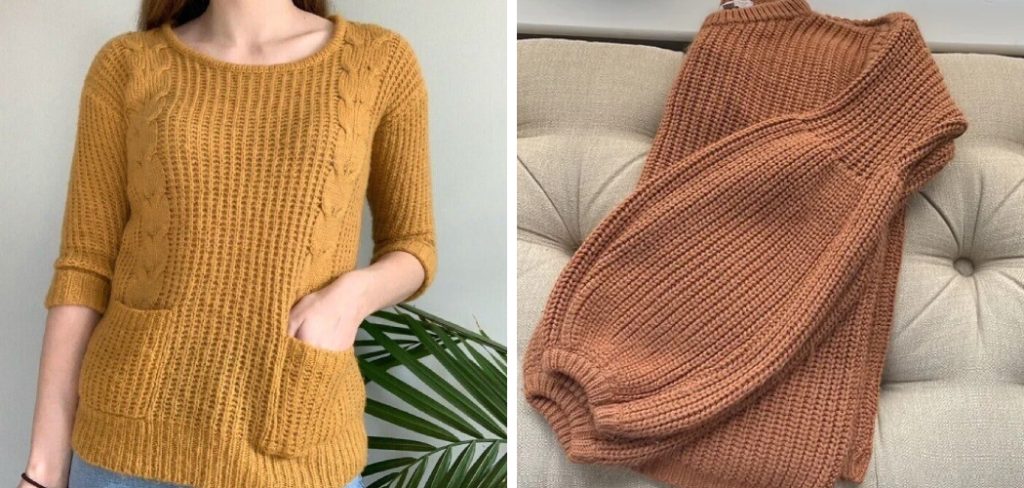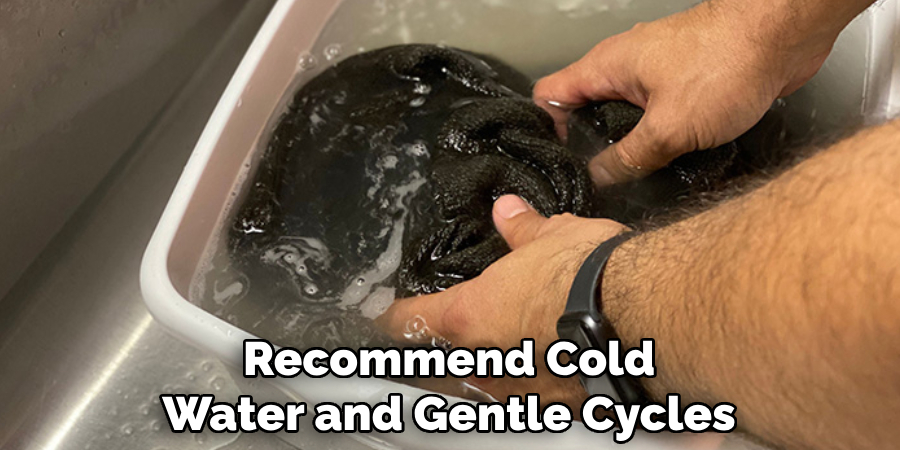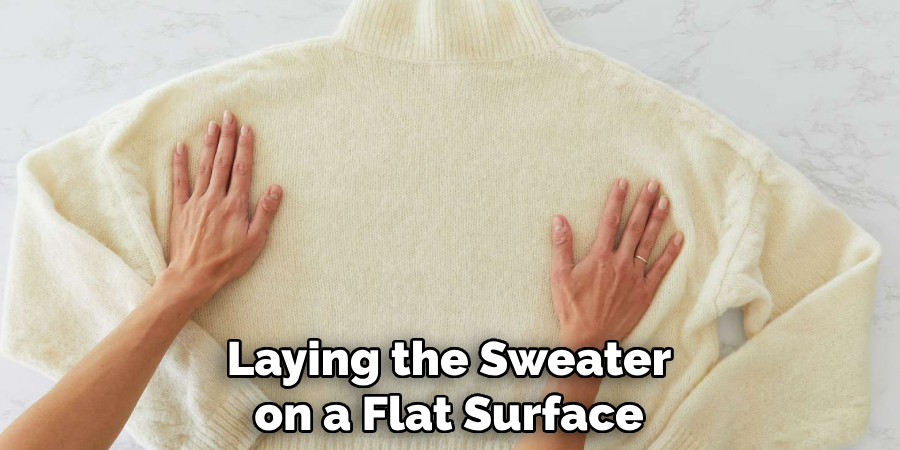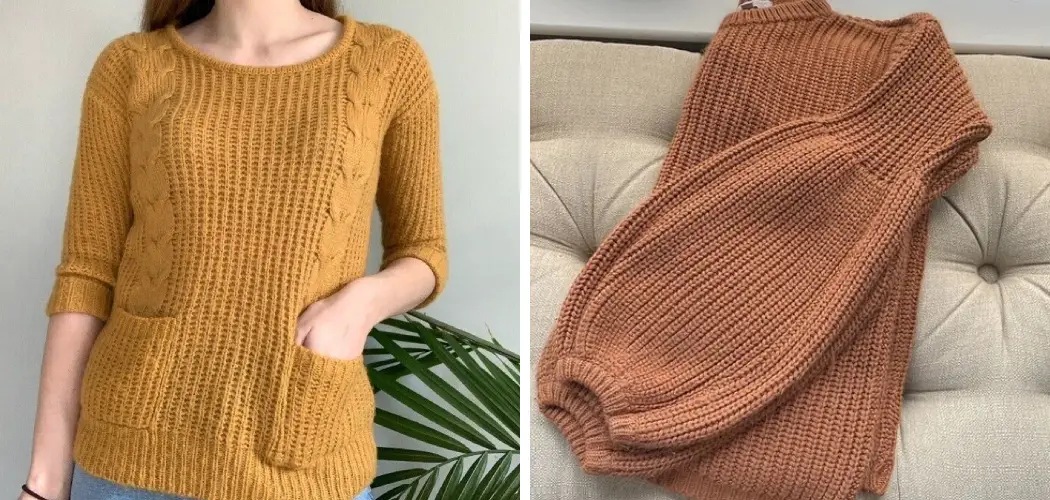Acrylic sweaters are revered for their wool-like warmth and low-maintenance care, yet they are notorious for their propensity to shrink post-wash. For many, a favorite sweater losing its original comfy fit is a wardrobe calamity, prompting a search for methods on how to stretch an acrylic sweater back to its former glory. While the resilient nature of acrylic fibers does allow for some manipulation, it’s essential to approach this task with tempered expectations; not all shrinkage can be reversed, and overzealous efforts may lead to garment damage.

This article delves into the delicate science of stretching acrylic sweaters, offering a swath of strategies from gentle hand stretching to the more adventurous boiling water soak while focusing on preserving the integrity of your cherished knitwear.
Understanding Acrylic: The Science of Stretchiness
1. Fiber Properties:
Acrylic fibers, the foundation of many synthetic sweaters, offer unique characteristics that set them apart from natural yarns. As a synthetic option, acrylic is designed to mimic the warmth of wool while providing improved durability and resistance to moths and mildew. However, it’s crucial to dispel the myth that acrylic stretches readily; unlike natural fibers such as cotton or wool, acrylic possesses a natural resistance to stretching due to its thermoplastic nature.
The fibers are heat-sensitive, which means that high temperatures can break down the fiber’s structure and lead to a loss of shape retention. Therefore, handling these garments with an understanding of their properties is key to maintaining their original size and silhouette.
2. Why Sweaters Shrink:
Shrinkage in acrylic garments can often be traced back to heat and mechanical stress, such as those encountered in a typical wash cycle. The combination of hot water and the agitation from washing machines can distort the bind of the fibers, prompting them to tighten and shorten – a process analogous to the coiling of a spring under pressure, resulting in a downsized garment.

Following the care instructions, which typically recommend cold water and gentle cycles, is paramount to circumvent this involuntary resizing. In case of any uncertainty, consulting the tag for specific guidelines can prevent the mishap of unintentional shrinkage, thus extending the life and fit of your acrylic sweater.
Before You Stretch: Consider Alternatives
Accepting the New Fit:
Before attempting to alter your acrylic sweater, consider embracing its new size. A shrunken sweater can often find a new lease on life with creative styling. Layering it over a collared shirt or pairing it with high-waisted trousers can give it a fresh appeal. Additionally, accessories like brooches or scarves can draw attention and craft a new fashion statement. If the fit is no longer to your taste, the sweater could serve as a thoughtful gift or find a second owner through resale, extending its life beyond your wardrobe and reducing waste.
Professional Tailoring:
Professional tailoring could be a viable option for alterations that exceed the scope of simple stretching. Experienced tailors can assess the fabric’s potential and perform more complex adjustments to rejuvenate the sweater’s fit. However, one must consider the cost of tailoring against the sweater’s value and emotional significance. In some cases, the investment in tailoring might outweigh the cost of replacing the garment. It’s worth evaluating the sweater’s sentimental and monetary value before proceeding with this adjustment method.
How to Stretch an Acrylic Sweater: A Calculated Approach
Stretching an acrylic sweater requires precision and patience to ensure the garment remains intact and reaches the desired dimensions. Cautiously manipulating the fabric calls for a gentle touch and measured actions.
1. Gentle Hand-Stretching:
When it comes to gentle hand-stretching, the key is to work with damp areas—never overly wet—as the slight moisture allows the fibers to make the fibers become more pliable. This method involves laying the sweater on a flat surface, pressing down, and stretching the material gently in areas that have shrunk. It is crucial to maintain the original shape, being mindful of the sweater’s construction.

Begin with small stretches and incrementally increase the force applied, but if the fabric offers resistance or shows any signs of damage, such as pulling at the seams or misshaping of the knit pattern, cease immediately. Work symmetrically from multiple points to ensure a uniform stretch and avoid distortion, gradually expanding outward from the sweater’s center.
2. Warm Water Soak:
Alternatively, the warm water soak method requires submerging the sweater in mildly warm water, mixed with a gentle detergent, to relax the fibers. Be careful not to use hot water that could further shrink or damage the sweater, and adhere scrupulously to the care instructions. While immersed, tenderly stretch the sweater, applying sufficient force and preserving the knit integrity.
Following the soak, carefully remove the sweater without wringing it, which can cause undesirable shape changes. The next step is to lay the sweater flat on a towel, shaping it to the desired fit and allowing it to air dry. During this drying phase, it’s important to periodically check and readjust the sweater to ensure it remains in the correct shape as it dries.
Both stretching techniques emphasize patience and the importance of letting the sweater’s fibers dictate how much they can adapt without risking damage. With these strategies, you can gradually bring your treasured acrylic sweater closer to its original dimensions.
Conditioning and Care: Protecting Your Restored Sweater
Restoring your sweater’s size is just the first step; proper conditioning and care are paramount to maintaining its appearance and feel. Preserving the adjusted fit requires ongoing attention to the garment’s cleaning and storage processes.
Hair Conditioner Trick:
An unconventional but effective method for treating your sweater’s fibers is using a diluted hair conditioner solution. This can help to soften the acrylic fibers, making them more amenable to stretching and restoring their original feel. To apply this technique, mix a small amount of hair conditioner in lukewarm water and immerse your sweater, allowing it to soak for a few minutes.

The concentration should be enough to feel slick but not so much that it’s difficult to rinse out. Thorough rinsing is crucial to prevent any residue that might attract dirt or dull the yarn’s sheen. Before applying this method to the entire garment, test it on a small, inconspicuous area to ensure there’s no adverse reaction. Once the process is complete, gently press the excess water out and proceed with air drying.
Proper Washing and Drying:
Restoring your acrylic sweater also reminds you to revisit proper garment care techniques. Always refer to and follow the sweater’s care instructions, favoring handwashing or machine washing on a delicate cycle using cool water and mild detergent. These actions help prevent future unintentional shrinkage and preserve the fabric’s elasticity.
After washing, avoid wringing the sweater; instead, lay it flat on a clean towel, carefully stretch it to its newly restored shape, and allow it to air dry completely. This method ensures the fibers are not stressed, retaining their shape and preventing further shrinkage. Regular and attentive care will keep your restored acrylic sweater looking its best for future seasons. That’s it! You’ve now learned how to stretch an acrylic sweater.
Going the Extra Mile: Risky Business Stretching
While the previously mentioned methods provide safer options for stretching out an acrylic sweater, some may wish to explore significantly riskier methods. These techniques are not recommended for the faint-hearted or treasured garments due to their potential to cause irreparable damage.
Steam Stretching:
Steam stretching is a daring technique that uses the power of steam to relax sweater fibers, allowing for possible stretching. The procedure involves using a garment steamer to gently emit steam at the fabric while simultaneously pulling it to the desired shape. WARNING: This method comes with a high risk of damage, including fiber distortion, discoloration, or creating an uneven texture.

It should only be attempted on sturdier sweaters and always first tested on a hidden section. Keep a steamer moving to avoid overexposure, and hold it at least a few inches away from the garment to control steam intensity. Apply uniform stretching in all directions for even results, and allow the sweater to cool down in the stretched position.
Boiling Water Soak (Expert Only):
EXTREME CAUTION ADVISED: The boiling water soak is a drastic measure involving immersing a sweater in boiling water, which can facilitate extreme relaxation for stretching purposes. This practice entails a considerable risk of damage, including irreversible shrinking or felted textures. It is recommended only for experienced individuals with bulky, sturdy sweaters that they are prepared to lose if things go awry.
To undertake this perilous process, quickly submerge the sweater in boiling water and then immediately stretch it to shape with great caution, avoiding any harsh pulling that could deform the knit. Remember that this technique is highly speculative and should only be a last resort, considering any unwanted outcomes’ inherent dangers and finality.
Troubleshooting and Damage Control
Recognizing Unsuccessful Attempts:
When attempting to stretch an acrylic sweater, it’s important to know when to stop to avoid causing irreversible damage. Signs such as visible stretching or distortion of seams, unusually thinning fabric, or areas of discoloration indicate that the sweater has been compromised. The stretching process may have gone too far if these signs are present.
In some cases, the new size and shape of the sweater may still be wearable, but if the fit is not right or the damage is too noticeable, seeking a professional’s help for repair or resizing may be the best option. Unfortunately, there comes a point when accepting the sweater’s altered state is necessary, especially if damage is extensive.
Preventing Further Shrinkage:
The longevity of an acrylic sweater largely depends on proper care and maintenance. To prevent further shrinkage and maintain shape, following the specified washing and drying instructions on the sweater’s label is crucial. Handwashing in cool water with a gentle detergent or using the delicate cycle in a machine can preserve the quality of the fabric. After cleaning, laying the sweater out on a flat surface to air dry will help to eliminate additional stress on the fibers.

To avoid creases and misshaping, store sweaters folded in drawers or on shelves. Hanging can cause the material to stretch under its own weight, so it’s best avoided. For a quick refresh that doesn’t involve washing, fabric sprays can be a good alternative; they help neutralize odors and add a pleasant scent. Another option is airing out the sweater in a well-ventilated area or outside on a breezy day, which can breathe new life into the garment without the need for a complete wash. These measures are not only preventative but can also extend the life and look of your sweaters, allowing you to enjoy them for many more wears.
Embracing Imperfections: The Beauty of Uniqueness
In pursuing the perfect fit, it’s essential to embrace the innate uniqueness of caring for acrylic sweaters. A slight shift in size or shape should not denote failure but rather a new aspect of the garment’s evolving character. Instead of discarding a sweater for minor changes, acknowledging and even appreciating the beauty of its imperfections echoes a sustainable mindset.
This perspective aligns with a broader, more conscious approach to consumption — one that prizes long-term value over the impulse of a quick fix. In a society where the ‘new’ is often celebrated, choosing to maintain and adapt to the idiosyncrasies of our clothing strengthens our commitment to reducing waste and supporting an environment-conscious lifestyle.
Should a sweater shrink beyond wearability, creative upcycling presents many opportunities. Those with a penchant for crafts can transform snug sweaters into warm hats, cozy scarves, or even unique decorative throws. These repurposed items carry a history, infusing a personal touch into what might have been relegated to a forgotten corner of the closet or, worse, a landfill. Through such resourcefulness, we give new life to the beloved fabric and reinforce the values of mindful consumption and resource conservation, fashioning a trend towards a more sustainable and less wasteful future.

5 Benefits of Stretching an Acrylic Sweater
Sweaters made of acrylic knits are popular for their affordability, vibrant color retention, and the fact that they don’t wrinkle or shrink easily. But what do you do when your cozy acrylic sweater no longer fits right? Have you considered the often-overlooked option of stretching it? Here are five compelling reasons why stretching your acrylic sweater might just be the wardrobe solution you’ve been looking for.
1. Improved Fit
Sweater styles can vary; sometimes, the fit you bought doesn’t quite match the one you need. Stretching allows you to tailor your sweater’s fit to your current preferences. Whether you’ve dropped a few pounds or just want a more relaxed feel, gently stretching the knit can give you the precise fit you’re after. The process is smooth and, when done correctly, imperceptible to the eye, ensuring that your favorite sweater feels like it was custom-made for you.
2. Enhanced Comfort
Feeling comfortable in your clothes is non-negotiable. A sweater that hugs you in all the right places makes for a more enjoyable wear. By stretching your acrylic sweater, you create more room in the shoulders, arms, or body – depending on where you need it – thus enhancing the overall comfort level. It’s like a warm, comforting hug from your clothes, exactly how your wardrobe should make you feel!
3. Versatility
An acrylic sweater that has been stretched becomes a far more versatile item in your closet. If you find that a sweater has shrunken in the wash or has just never quite fit your layering plans, stretching it can open up a whole new range of styling possibilities. Suddenly, it can be layered over longer shirts or even become a slouchy off-the-shoulder piece for a completely different look.
4. Prolonged Lifespan
Every piece of clothing has a story, and we all want that story to continue for as long as possible. By stretching an acrylic sweater, you can potentially prevent the fibers from tightening up over time, a common issue that often arises after washing. Tightening of the fibers can cause an unsightly warp to the garment and may even damage the fabric. An occasional stretch can help maintain the sweater’s original shape and preserve its integrity.
5. Cost-Effective Solution
At the end of the day, stretching a sweater is a cost-effective solution to replacing them. Acrylic sweaters, while durable, are not indestructible, and sometimes a shrunken sweater can feel like a lost investment. But with a simple at-home stretching routine, you can save money on buying a new one. It’s a sustainable practice that saves you money and reduces your fashion-related waste.

Conclusion
In this comprehensive guide on how to stretch an acrylic sweater, we’ve explored methods ranging from gentle hand-stretching to risky boiling water soaks, weighing each procedure’s potential risks against its benefits. The key is cautious experimentation, armed with knowledge of when to cease stretching to prevent damage.
Remember to manage expectations; a sweater’s transformation may yield a unique character to be valued, not discarded. We encourage responsible, environment-conscious practices while you endeavor to fit your knit. Thank you for joining us on this journey. Good fortune in your garment care, and may each acrylic sweater’s distinctiveness enhance your fashion repertoire.

